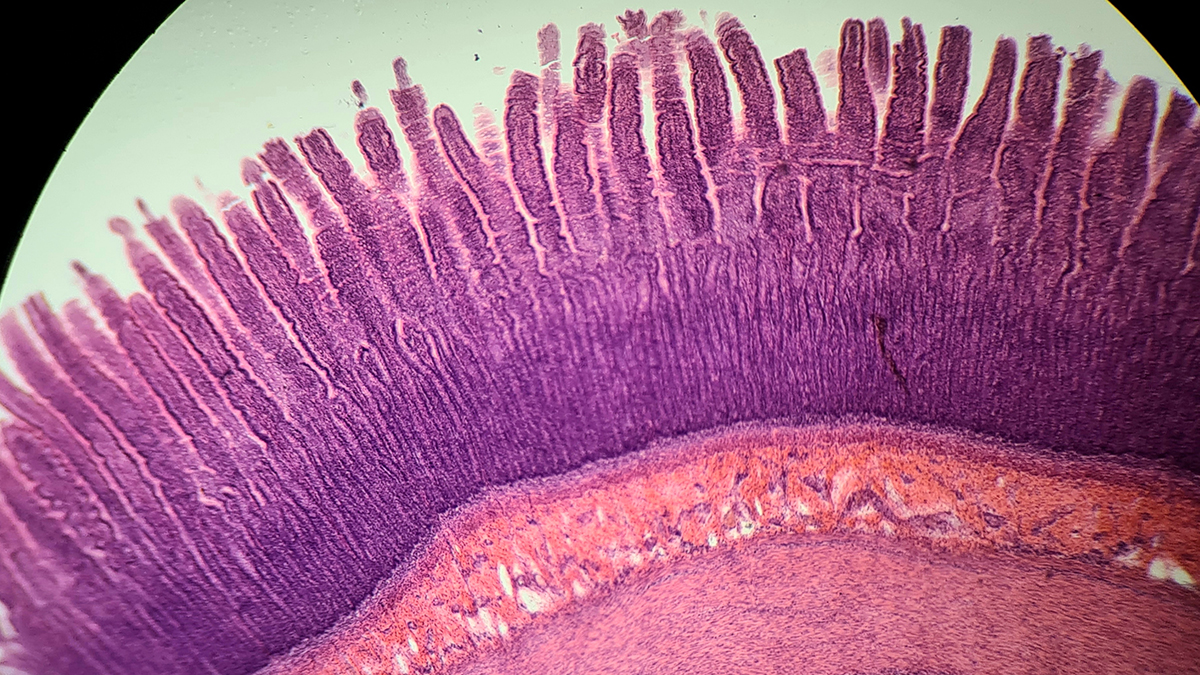⑴ 便秘と腸内細菌の乱れ
現代人に多くみられる便秘は、腸の運動(蠕動運動)の低下、食物繊維や水分の不足、腸内細菌叢の異常、ストレス、運動不足など複数の要因が関与しています。[1]
特に、腸内細菌叢(マイクロバイオーム)のバランスが崩れることで、有害菌が優勢になり、便の通過時間が遅くなることが知られています。[2]

Microbiome intestine factories and microbiota.
腸内には、善玉菌(例:ビフィズス菌、乳酸菌)と悪玉菌(日和見菌を含む)が共存していますが、高脂肪・高タンパク・低食物繊維の食事が続くと、悪玉菌が優勢になり、腸内環境は悪化してしまうのです。
これにより、腐敗産物やガス、アンモニア、有害なフェノール類が腸内に充満し、便秘だけでなく、慢性的な腹部膨満感や皮膚トラブル、体臭の悪化、全身の炎症反応を引き起こす可能性があります。[3]

Permanent preparation of intestinal villi under a microscope
⑵ 大腸炎・過敏性腸症候群とバリア機能
潰瘍性大腸炎やクローン病といった炎症性腸疾患(IBD)、あるいは過敏性腸症候群(IBS)などは、腸のバリア機能が破綻し、異物や毒素、細菌などが腸壁を通過することによって免疫系が過剰反応することで発症・悪化すると考えられています。[4]
腸の粘膜バリアは、腸上皮細胞とそれを覆う粘液層、免疫細胞群から構成されており、これらのバリアを強化するうえでビタミンA、ビタミンD、亜鉛、L-グルタミンなどの栄養素が有効です。[5・6]
また、プロバイオティクス(善玉菌)やプレバイオティクス(善玉菌の餌)の摂取は、腸内細菌の健全なバランスを取り戻す助けになります。
加えて、発酵食品(味噌、漬物、ヨーグルトなど)や食物繊維の豊富な野菜、海藻、豆類などの伝統的な食事スタイルが腸内環境を整えることが、疫学研究からも支持されています。[7]

⑶ 糖質過剰と腸トラブル
砂糖や精製炭水化物を過剰に摂取することは、腸内でカンジダ菌などの真菌類の異常増殖を引き起こす原因にもなり、慢性の便秘や下痢、炎症、さらには精神症状(ブレインフォグ、不安感)などとも関係していると報告されています。[8]

References
- Müller-Lissner, S. A., et al. (2005). “Myths and misconceptions about chronic constipation.” The American Journal of Gastroenterology, 100(1), 232–242.
- Sekirov, I., et al. (2010). “Gut microbiota in health and disease.” Physiological Reviews, 90(3), 859–904.
- O’Keefe, S. J. D. (2016). “Diet, microorganisms and their metabolites, and colon cancer.” Nature Reviews Gastroenterology & Hepatology, 13(12), 691–706.
- Turner, J. R. (2009). “Intestinal mucosal barrier function in health and disease.” Nature Reviews Immunology, 9(11), 799–809.
- Siva, S., et al. (2008). “L-Glutamine therapy for inflammatory bowel disease.” Nutrition, 24(7-8), 709–717.
- Iwata, M., & Yokota, A. (2011). “Vitamin D and the immune system: Role in protection against autoimmunity and infectious diseases.” Inflammation and Allergy-Drug Targets, 10(4), 223–230.
- Roberfroid, M., et al. (2010). “Prebiotic effects: metabolic and health benefits.” British Journal of Nutrition, 104(S2), S1–S63.
- Pimentel, M., et al. (2013). “Small intestinal fungal overgrowth.” Digestive Diseases and Sciences, 58(1), 120–123.




 トップへ戻る
トップへ戻る